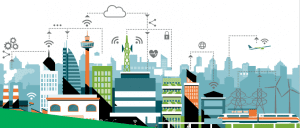As the Internet of Things networks connect devices and systems across a city, automation, artificial intelligence and real-time data acquisition come together to create Urban Environments that can ‘think for themselves’. Data sourced from a range of systems in the community such as Smart Poles, Embedded Power Networks and Smart Buildings can be applied in real time so that the urban environment can adapt dynamically to changes in people and vehicle movement as well as local environmental conditions to optimise efficiency in the use of energy and water as well as safety and security outcomes for the community.

RESIDENT AND COMMUNITY BENEFITS
Increasing urban density in cities has the ability to deliver more than simple bottom-line improvements for developers. Smart Cities have the potential to improve the lifestyle of both individual residents and communities.
Examples include:
- Superfast fixed line telecommunications to support streaming of entertainment as well as commercial grade services for education, medical, business and innovation hubs
- Wireless coverage of parks and community spaces for mobile devices
- Underground infrastructure – visually appealing without power lines, antennas and satellite dishes on dwellings
- Reduced utility costs for residents and owners’ corporations through embedded utilities
- Activated precincts with feature lighting and community displays
- Safety and security of public spaces can be enhanced
- Residents feel that they are living in a sustainable community with a reduced carbon footprint
- Councils can reduce lighting costs through motion sensing and daylight harvesting
- Recycled water can be reticulated in parks, gardens and green walls
- Residents can understand the mix of renewables they consume and make choices in real time
- Solar and Battery storage can be aggregated at the community level creating a micro-grid to power community facilities
- Environmental monitoring at a local level can enable granular real-time responses by smart building infrastructure
- Flexible infrastructure to support future services and innovation such as autonomous transport
- Real time data analytics can contribute to understanding how residents and communities are interacting with the urban environment so that short-term strategies for improved urban activation can be developed as well as contributing to knowledge for long-term urban planning
Guest blog by Opticomm